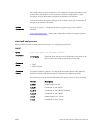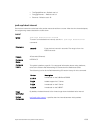
key-
encryption-
type
(OPTIONAL) Specifies if the key is encrypted.
Valid values: 0 (key is not encrypted) or 7 (key is encrypted).
key
Text string used in authentication.
For MD5 authentication, the key must be 32 hex digits (non-
encrypted) or 64 hex digits (encrypted).
For SHA-1 authentication, the key must be 40 hex digits
(non-encrypted) or 80 hex digits (encrypted).
Defaults Not configured.
Command
Modes
INTERFACE
Command
History
This guide is platform-specific. For command information about other platforms,
refer to the relevant Dell Networking OS Command Line Reference Guide.
The following is a list of the Dell Networking OS version history for this command.
Version Description
9.1.(0.0) Introduced on S4810 and Z9000.
8.4.2.0 Introduced on the E-Series.
8.3.19.0 Introduced on the S4820T.
Usage
Information
Before you enable IPsec authentication on an OSPFv3 interface, first enable IPv6
unicast routing globally, configure an IPv6 address and enable OSPFv3 on the
interface, and assign the interface to an area.
An SPI value must be unique to one IPsec security policy (authentication or
encryption) on the router. Configure the same authentication policy (same SPI and
key) on each OSPFv3 interface in a link.
To remove an IPsec authentication policy from an interface, enter the no ipv6 ospf
authentication spi number command. To remove null authentication on an
interface to allow the interface to inherit the authentication policy configured for
the OSPFv3 area, enter the
no ipv6 ospf authentication null command.
Related
Commands
area authentication – configures an IPsec authentication policy for an OSPFv3
area.
show crypto ipsec policy – displays the configuration of IPsec authentication
policies.
1356
Open Shortest Path First (OSPFv2 and OSPFv3)


















